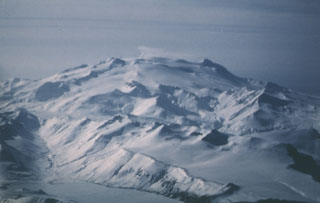Report on Makushin (United States) — 2 September-8 September 2020
Smithsonian Institution / US Geological Survey
Weekly Volcanic Activity Report, 2 September-8 September 2020
Managing Editor: Sally Sennert.
Please cite this report as:
Global Volcanism Program, 2020. Report on Makushin (United States) (Sennert, S, ed.). Weekly Volcanic Activity Report, 2 September-8 September 2020. Smithsonian Institution and US Geological Survey.
Makushin
United States
53.891°N, 166.923°W; summit elev. 1800 m
All times are local (unless otherwise noted)
Seismicity at Makushin returned to background levels after steadily declining for almost three months following a sequence of earthquakes about 10 km E of the summit at a depth of 8 km that had started on 15 June. AVO lowered the Aviation Color Code and Volcano Alert Level remained at Green and Normal, respectively, on 8 September.
Geological Summary. The ice-covered Makushin volcano on northern Unalaska Island is capped by a 2.5 km caldera. Its broad, dome-like structure contrasts with the steep-sided profiles of most other Aleutian stratovolcanoes. Much of the edifice was formed during the Pleistocene, but the caldera (which formed about 8,000 years ago), Sugarloaf cone on the ENE flank, and a cluster of about a dozen explosion pits and cinder cones at Point Kadin on the WNW flank, are of Holocene age. A broad band of NE-SW-trending vents cuts across the volcano. The composite Pakushin cone, with multiple summit craters, lies 8 km SW. Table Top (Pleistocene, 68 +/- 14 ka) and Wide Bay (Holocene) cinder cones are about 20 km ENE on the peninsula across the bay from the City of Unalaska. Frequent explosive eruptions have occurred during the past 4,000 years, sometimes accompanied by pyroclastic flows and surges. Geothermal areas are found in the summit caldera and on the SE and E flanks. Small-to-moderate explosive eruptions have been recorded since 1786.
Source: US Geological Survey Alaska Volcano Observatory (AVO)

